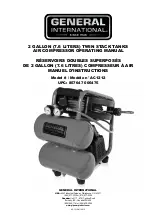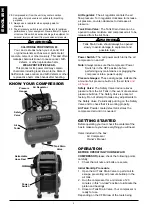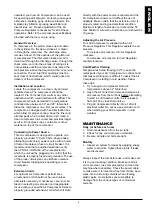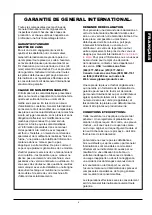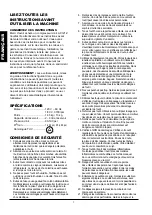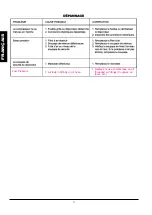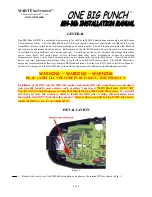
English
4
operated, your new Air Compressor can be used
for operating paint sprayers, air tools, grease guns,
airbrushes, caulking guns, abrasive blasters, tire
& plastic toy inflation, spraying weed killer and
insecticides, etc. Proper adjustment of the Air
Pressure Regulator is necessary for all of these
operations. Refer to the air pressure specifications
provided with the tool you are using.
General Overview
To compress air, the piston moves up and down
in the cylinder. On the down stroke air is drawn
in through the valve inlet. The discharge valve
remains closed. On the upstroke of the piston air
is compressed. The inlet valve closes and air is
forced out through the discharge valve, through the
check valve, and into the air tank. Working air is
not available until the compressor has raised the
tank pressure above that required at the air service
connection. The air inlet filter openings must be
kept clear of obstructions, which could reduce air
delivery of the compressor.
Installation and location
Locate the compressor in a clean, dry and well
ventilated area. The compressor should be
located 12 to 18 inches from walls or any other
obstruction which would interfere with airflow. The
compressor should be located in a temperature
controlled area between 32° and 95° fahrenheit.
Place the compressor on a firm, level surface. The
compressor is designed with heat dissipation fins
which allow for proper cooling. Keep the fins (and
all other parts which collect dust or dirt) clean. A
clean compressor runs cooler and provides longer
service. Do not place rags, containers or other
material on top of the compressor.
Connecting to Power Source
This air compressor is designed to operate on a
properly grounded 120 volt, 60Hz, single phase,
alternating current (ac) power source with a fused
20 amp time delayed fuse or circuit breaker. It is
recommended that a qualified electrician verify
the ACTUAL VOLTAGE at the receptacle into
which the unit will be plugged and confirm that the
receptacle is properly fused and grounded. The use
of the proper circuit size can eliminate nuisance
circuit breaker tripping while operating your air
compressor.
Extension Cords
For optimum Air Compressor performance
an extension cord should not be used unless
absolutely necessary. If necessary, care must be
taken in selecting an extension cord appropriate
for use with your specific Air Compressor. Select a
properly grounded extension cord which will mate
directly with the power source receptacle and the
Air Compressor power cord without the use of
adapters. Make certain that the extension cord is
properly wired and in good electrical condition.
Maximum length of extension cord should be 50
feet. Minimum wire size of extension cord should be
12 gauge.
Adjusting the Air Pressure
Your Air Compressor is supplied with an Air
Pressure Regulator. This Regulator adjusts the air
pressure.
To increase air pressure, turn Air Regulator
clockwise.
To decrease air pressure, turn Air Regulator
counterclockwise.
Cold Weather Starting
Temperatures below freezing (32°F) cause the
metal parts of your Air Compressor to contract and
that makes starting more difficult. To assist the Air
Compressor in starting in cold weather, follow
these tips:
1. Try to keep Air Compressor stored in
temperatures above 32° fahrenheit.
2. Open the Air Tank Drain Valve and release all
air pressure from the Air Tank before attempting
to start in cold weather. (After air is released
from Air Tank, close Drain Valve.)
3. Plug Air Compressor directly into a 120 volt
electrical outlet. Do not use an extension cord
when starting your Air Compressor in cold
weather.
MAINTENANCE
Daily (or before each use)
1. Drain condensation from the air tank.
2. Check for any unusual noise or vibration.
3. Be sure all nuts and bolts are tight.
Monthly
1. Inspect air system for leaks by applying soapy
water to all joints. Tighten these joints if leaks
are discovered.
Always inspect the tool before use, and make sure
it is in good working condition. Make sure all air
vents are clear, (use compressed air to clean the
machine where possible). Check the power cable
to make sure it is intact and free from cracks, bare
wires etc. Avoid using solvents when cleaning
plastic parts, most plastics are susceptible to
damage from the various types of commercial
solvents.

